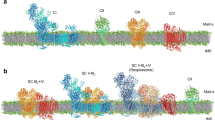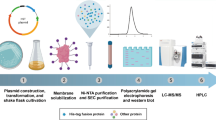Abstract
The 8-kDa subunit c of theE. coli F0 ATP-synthase proton channel was tested for Ca++ binding activity using a45Ca++ ligand blot assay after transferring the protein from SDS-PAGE gels onto polyvinyl difluoride membranes. The purified subunit c binds45Ca++ strongly with Ca++ binding properties very similar to those of the 8-kDa CF0 subunit III of choloroplast thylakoid membranes. The N-terminal f-Met carbonyl group seems necessary for Ca++ binding capacity, shown by loss of Ca++ binding following removal of the formyl group by mild acid treatment. The dicyclohexylcarbodiimide-reactive Asp-61 is not involved in the Ca++ binding, shown by Ca++ binding being retained in twoE. coli mutants, Asp61→Asn and Asp61→Gly. The Ca++ binding is pH dependent in both theE. coli and thylakoid 8-kDa proteins, being absent at pH 5.0 and rising to a maximum near pH 9.0. A treatment predicted to increase the Ca++ binding affinity to its F0 binding site (chlorpromazine photoaffinity attachment) caused an inhibition of ATP formation driven by a base-to-acid pH jump in whole cells. Inhibition was not observed when the Ca++ chelator EGTA was present with the cells during the chlorpromazine photoaffinity treatment. An apparent Ca++ binding constant on the site responsible for the UV plus chlorpromazine effect of near 80–100 nM was obtained using an EGTA-Ca++ buffer system to control free Ca++ concentration during the UV plus chlorpromazine treatment. The data are consistent with the notion that Ca++ bound to the periplasimic side of theE. coli F0 proton channel can block H+ entry into the channel. A similar effect occurs in thylakoid membranes, but the Ca++ binding site is on the lumen side of the thylakoid, where Ca++ binding can modulate acid-base jump ATP formation. The Ca++ binding to the F0 and CF0 complexes is consistent with a pH-dependent gating mechanism for control of H+ ion flux across the opening of the H+ channel.
Similar content being viewed by others
References
Altendorf, K., Schmid, R., Decker, C., and Wachter, E. (1980).Hoppe-Seyler's Z. Physiol. Chem. 361, 1474.
Bers, D. M., Patton, C. W., and Nuccitelli, R. (1994). InMethods in Cell Biology (Nuccitelli, R., ed.). Academic Press, New York, Vol. 40, pp. 1–29.
Charuk, J. H. M., Pirraglia, C. A., and Reithmeyer, A. F. (1990).Anal. Biochem. 188, 123–131.
Chazotte, B., Vanderkooi, G., and Chignell, D. (1982).Biochim. Biophys. Acta 680, 310–316.
Chiang, G. G., and Dilley, R. A. (1987).Biochemistry 26, 4911–4916.
Chiang, G. G., Wooten, D. C., and Dilley, R. A. (1992).Biochemistry 31, 5808–5819.
Dilley, R. A. (1991).Curr. Top. Bioenerg. 16, 265–318.
Demmig, B., Winter, K., Krüger, A., and Czygan, F-C. (1987).Plant Physiol. 84, 218–224.
Demmig-Adams, B. (1990).Biochim. Biophys. Acta 1020, 1–24
Ferguson, S. J. (1985).Biochim. Biophys. Acta 811, 47–95.
Fillingame, R. H., Peters, L. K., White, L. F., Mosher, M. E., and Paule, C. R. (1984)J. Bacteriol. 158, 1078–1083.
Gilmore, A. M., and Yamamoto, H. Y. (1991).Plant Physiol. 96, 635–643.
Girvin, M. E., and Fillingame, R. N. (1993).Biochemistry 32, 12167–12177.
Good, N. E., Izawa, S., and Hind, G. (1966).Curr. Top. Bioenerg. 1, 75–112.
Grynkiewicz, G., Poenie, M., and Tsien, R. Y. (1985).J. Biol. Chem. 260, 3440–3450.
Hochman, Y., and Carmeli, C. (1981).Biochemistry 20, 6287–6292.
Ikeuchi, M., Hirano, A., Hiyama, T., and Inoue, Y. (1990).FEBS Lett. 263, 274–278.
Jagendorf, A. T., and Uribe, E. (1966).Proc. Nat. Acad. Sci. USA 55, 170–177.
Junesch, U., and Gräber, P. (1987).Biochim. Biophys. Acta 893, 275–288.
Krulwich, T. A. (1995).Mol. Microbiol. 15, 403–410.
Lötscher, H. R., de Jong, C., and Capaldi, R. A. (1984).Biochemistry 23, 4128–4134.
Maloney, P. C., Kashket, E. R., and Wilson, T. H. (1974).Proc. Nat. Acad. Sci. USA 71, 3896–4001.
Maruyama, K., and Nomura, Y. (1984).J. Biochem. (Tokyo) 96, 859–870.
Massom, L., Lee, H., and Jarrett, H. W. (1990).Biochemistry 29, 671–681
McPhelan, C. A., Strynadka, N. C. J., and James, M. N. G. (1991).Adv. Protein Chem. 42, 77–144.
Miller, M. J., Fraga, D., Paule, C. R., and Fillingame, R. H. (1989).J. Biol. Chem. 264, 305–311.
Moody, M. F., Jones, P. T., Carver, J. A., Boyd, J., and Campbell, I. D. (1987).J. Mol. Biol. 193, 759–774.
Murata, N., Miyao, M., Hayashida, N., Hidaka, T., and Sugiura, M. (1988).FEBS Lett. 235, 283–288.
Neuburger, M., Journet, E. P., Bligny, R., Carde, J. P., and Douce, R. (1982).Arch. Biochem. Biophys. 217, 312–323.
Noctor, G., Rees, D., Young, A., and Horton, P. (1991).Biochim. Biophys. Acta 1057, 320–336.
Owens, T. G. (1994). InPhotoinhibition of Photosynthesis (Baker, N. R., and Bowyer, J. R., eds.), BIOS Sci. Publ, Butterworth-Heinemann, Oxford, pp. 95–109.
Pfündel, E., Renganathan, M., Gilmore, A., Yamamoto, H. Y., and Dilley, R. A. (1994).Plant Physiol. 106, 1647–1658.
Prozialeck, W. C., Cimino, M., and Weiss, B. (1981).Mol. Pharmacol. 19, 264–269.
Renganathan, M., Pfündel, E., and Dilley, R. A. (1993).Biochim. Biophys. Acta 1142, 277–292.
Roberts, D. M., Lukas, T. J., and Watterson, D. M. (1986).CRC Rev. Plant Sci. 4, 311–339.
Schägger, H., and von Jagow, G. (1987).Anal. Biochem. 166, 368–379.
Sebald, W., and Hoppe, J. (1981).Curr. Top. Bioenerg. 12, 1–64.
Strynadka, N. C. J., and James, M. N. G. (1989).Annu. Rev. Biochem. 58, 951–998.
Surek, B., Kreimer, G., Melkonian, M., and Latzko, E. (1987).Planta 171, 565–568.
Terwilliger, T. C., and Clarke, S. (1981).J. Biol. Chem. 256, 3067–3076.
Wachter, E., Schmid, R., Decker, C., and Altendorf, K. (1980).First European Bioenergetics Conference (E. Patron, ed.), Bologna, Italy, pp. 173–174.
Wooten, D. C., and Dilley, R. A. (1993).J. Bioenerg. Biomembr. 25, 557–567.
Zakharov, S. D., and Kuzmina, V. P. (1992).Biochemistry (Moscow) 57, 534–542
Zakharov, S. D., Ewy, R. G., and Dilley, R. A. (1993).FEBS Lett. 336, 95–99.
Zakharov, S. D., Ewy, R. G., and Dilley, R. A. (1995).Protoplasma 185, 42–49.
Author information
Authors and Affiliations
Additional information
This work was supported in part by grants from the Department of Energy and the U.S. Department of Agriculture.
On leave from the Institute of Soil Science and Photosynthesis, Russian Academy of Science, Pushchino, Russia.
Rights and permissions
About this article
Cite this article
Zakharov, S.D., Li, X., Red'ko, T.P. et al. Calcium binding to the subunit c ofE. coli ATP-synthase and possible functional implications in energy coupling. J Bioenerg Biomembr 28, 483–494 (1996). https://doi.org/10.1007/BF02110438
Received:
Accepted:
Issue Date:
DOI: https://doi.org/10.1007/BF02110438




